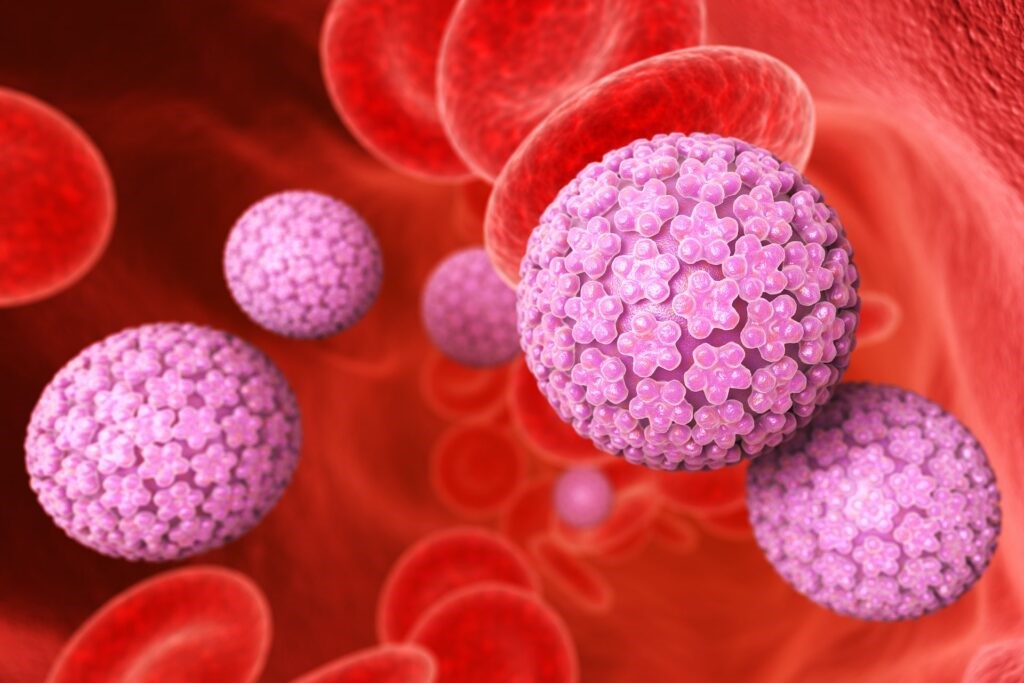
HPV (Human papillomavirus): symptoms, diagnosis and treatment of the papilloma virus
It is estimated that about 80% of sexually active women come into contact with the HPV virus during their lifetime, with a prevalence of 25-35 years. Therefore, knowing the infection well can help prevent it
What is the HPV virus
The Human Papilloma Virus (HPV) is one of the most widely transmitted viruses in the population.
There are over 120 HPV strains, subdivided according to their potential risk of evolving into a cancerous form or not.
Among them, serotypes 16 and 18 (but also 31, 33, 35, 39, 45, 51, 52, 56, 58, 59) have been identified as those with a high oncogenic risk; while 6 and 11 are among those responsible for the development of genital warts and condylomata.
In most cases the lesions will be benign and/or transitory; only in a small percentage does the infection progress to cervical cancer.
The virus is also implicated in the pathogenesis of other vaginal, vulvar and anal cancers.
How HPV is transmitted
The HPV virus is mainly contracted through sexual intercourse, not only by penetration, but also by contact between the genitals.
The main risk factors are young age, number of partners and frequency of sexual intercourse.
The infection can be transmitted many years after one partner has contracted it, and the fact of having the infection may have nothing to do with the current partner.
How it is diagnosed
The main methods of screening and early diagnosis of Hpv are the Hpv-Test and the Pap-Test.
They are essential for PREVENTION of the virus and, if done regularly, reduce the chance of developing cancer by about 70%.
It is a sampling, performed by the midwife or doctor, at the level of the cells of the cervix, done after introducing a speculum, with a special instrument (CervexBrush).
The examination lasts a few minutes and is not painful.
It is important that the woman is not menstruating, that she has not used vaginal creams, douches or ovules, and that she has not had sexual intercourse in the two days preceding the test.
The Hpv-Test checks for the presence or absence of the virus in the cells taken from the patient’s cervix (recommended every 5 years if negative), while the Pap-Test checks whether the virus, if present, has created lesions in the cells lining the cervix (recommended every 3 years if negative).
The Pap-Test is therefore used as a complementary test in screening with a primary Hpv test that is positive
A positive Hpv-Test does not necessarily mean that a woman will develop cancer over time, whereas a positive Pap-Test means that the patient has developed one of the possible lesions.
In the case of cellular abnormalities, colposcopy (an outpatient examination performed by a doctor specialising in gynaecology) is performed, and biopsies of the cervix tissue are taken if necessary.
After colposcopy, if the cervix is normal or only has mild lesions, the specialist in gynaecology will indicate the most appropriate treatment and follow-up checks.
All women between 25 and 65 years of age should perform such screening regularly throughout their lives, and it is also strongly recommended for all girls from the beginning of their sexual activity.
HPV prevention and treatment
In the event of a positive HPV-Test, the most important thing to do to treat HPV infection is to identify cellular changes caused by the virus in time, through the Pap-Test.
In addition to screening, prevention with VACCINES is also of paramount importance, especially for adolescent girls from the age of twelve.
There are various types of vaccines on the market: bivalent, tetravalent and nonavalent, depending on which serotypes are covered.
The vaccine is preventive, it therefore has no therapeutic effect and, to be useful, it must be carried out before exposure to the virus, preferably before the start of sexual activity (having already begun sexual activity is not, however, a contraindication to vaccination).
In any case, vaccination does not replace the usual secondary prevention of cervical cancer that is carried out by national screening programmes.
If, after colposcopy, histological examination of the biopsy reveals suspicious lesions, the most appropriate treatment will be indicated by the referring gynaecologist.
Read Also
Emergency Live Even More…Live: Download The New Free App Of Your Newspaper For IOS And Android
What Is The Papilloma Virus And How Can It Be Treated?
What Is Papilloma Virus And How Does It Occur In Men?
Pap Test, Or Pap Smear: What It Is And When To Do It
Rocketing Vaccine Cost Warning
The Vaccine Against HPV Lowers The Risk Of Relapse In Positive Women
HPV Vaccine: Why Vaccinating Against The Papilloma Virus Is Important For Both Sexes
Gynaecological Cancers: What To Know To Prevent Them
Vulvodynia: What Are The Symptoms And How To Treat It
What Is Vulvodynia? Symptoms, Diagnosis And Treatment: Talk To The Expert
Accumulation Of Fluid In The Peritoneal Cavity: Possible Causes And Symptoms Of Ascites
Accumulation Of Fluid In The Peritoneal Cavity: Possible Causes And Symptoms Of Ascites
What’s Causing Your Abdominal Pain And How To Treat It
Pelvic Varicocele: What It Is And How To Recognise The Symptoms
Can Endometriosis Cause Infertility?
Transvaginal Ultrasound: How It Works And Why It Is Important
Candida Albicans And Other Forms Of Vaginitis: Symptoms, Causes And Treatment
What Is Vulvovaginitis? Symptoms, Diagnosis And Treatment
Vaginal Infections: What Are The Symptoms?
Chlamydia: What Are The Symptoms And How To Treat It
Chlamydia, Symptoms And Prevention Of A Silent And Dangerous Infection
Tumours Of The Adrenal Gland: When The Oncological Component Joins The Endocrine Component
Papilloma Virus Infection And Prevention


